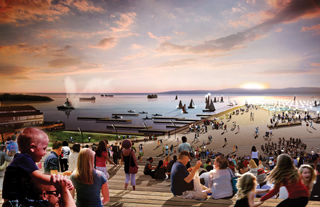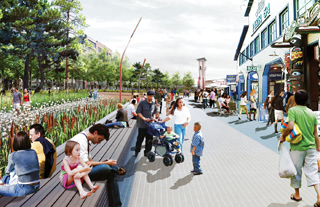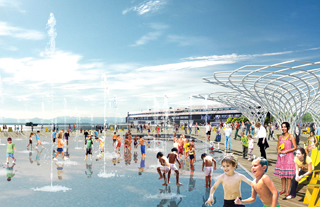|
Subscribe / Renew |
|
|
Contact Us |
|
| ► Subscribe to our Free Weekly Newsletter | |
| home | Welcome, sign in or click here to subscribe. | login |
Architecture & Engineering
| |
October 31, 2011
More 'really cool' waterfront ideas from James Corner team
Journal Staff Reporter
James Corner of New York City-based James Corner Field Operations presented his latest ideas for redeveloping Seattle's waterfront last week to a packed room of about 800 people. If just half his ideas become reality, the waterfront could be a remarkable place.
Since Corner's last presentation here in May, the team has refined the design, though nothing is concrete until the concept development phase is complete next spring.
Major redevelopment must wait until the Alaskan Way Viaduct is demolished, but the team wants to move forward with some early projects next summer.
Seattle Planning Director Marshall Foster said the goal is to reconnect Seattle with its waterfront, and to connect downtown neighborhoods. The waterfront work will also involve replacing the seawall, which is not funded. Seawall construction should start in 2013.
There is also no funding plan for the waterfront work yet. Cost estimates will be developed as part of the concept plan. Viaduct demolition, closing the Battery Street Tunnel and construction of a new Alaskan Way are estimated to cost $290 million.
In his presentation last week, Corner said his team is trying to figure out what specific things would bring people to the waterfront and put them into the design.
Corner's team is working with the seawall team and is trying to improve conditions for fish. The team also wants to start a tree-planting program and use greenery to connect the waterfront to Belltown and Pioneer Square.
Corner said he views the waterfront as both a linear element and a series of different sections. He said he is pushing for a long boulevard to connect it all.
“One of the best assets of a linear park is the capacity to actually go on a long bike ride or a long stroll... and go through a series of episodes as part of that journey,” Corner said.
Big changes
On the south end, Corner envisions putting a sizeable beach near Pioneer Square, between Pier 48 and Colman Dock. The beach would have large rocks and be graded down to the water. There would be a promenade and places to sit, and a dedicated bike and walking late adjacent to the street.
People could come here to touch the water and see wildlife, eat at a cafe or have a picnic.
The team also suggests putting a tugboat on the beach so children could play on it and learn about the area's maritime history.
South of the beach is Pier 48, owned by the Washington State Department of Transportation. The Corner team has dubbed it “festival pier” and is exploring how to create an event space or ampitheater at the end, next to the water. A boat dock would surround the pier, which would have large lawns for sunbathing, picnics and movies.
Corner said the team is focusing on creating a stronger connection between the city and the waterfront at Union Street. The space is tough because of the elevation change, so the team is looking at adding an elevator and a funicular or covered escalator.
It also wants to make the experience of moving down dramatic and theatrical, Corner said, and envisions something they call “the cloud.” A system would spray mist or fog along the downward path leading to a flat plaza that sometimes would be covered by a very thin flim of water. Some days the wet plaza would just reflect the sky. On warm days, it would become a water feature when jets embedded in the plaza get turned on and create places for children to play.
In the evening, the water could be turned off and create space for a concert or other events.
Corner said the area at the foot of Union Street is Seattle's best opportunity for waterfront space because it is dynamic.
Roller rinks, pools
Another area that could see a lot of change is near the aquarium and Pier 62/63. The team envisions an area where there are intertidal pools and where the seawall is exposed to show how it supports aquatic life.
Pier 63/63 could get a roller rink, a pool and hot tubs, a grandstand seating area with views across the bay, and a series of floats in the water for animals and kayakers. Corner said this area should be very active.
A temporary roller rink was installed at the base of Corner's High Line park in New York City, and surrounded by food trucks and a beer garden. Corner said the space was busy every hour of the day, and that could work here too.
Corner showed pictures of a waterfront pool in Vancouver, B.C., and a pool with a retractable roof on a barge in Germany. He said this type of pool on Pier 62/63 would bring people to the area year-round.
At last May's presentation, an image of hot tubs prompted laughter and disbelief. Corner said the response is important because it excited people's imagination, and made them think about the waterfront differently. He said hot tubs could be managed and wouldn't be “open for everyone to just jump on in.”
Corner had previously discussed plans to extend Victor Steinbrueck Park with a broad ramp to the waterfront. His most dramatic new image showed the bottom section of that ramp and a new aquarium built above the new Alaskan Way.
This would be a big statement, Corner said, and establish the waterfront as Seattle's special, cultural place.
“It's really cool, you've got to admit,” he said, while laughing as the audience applauded. “You do that, it's fantastic.
A two-level structure beneath the ramp would create space for restaurants and the team is considering adding office space to activate the area.
Mark Dion, the team's artist, spoke after Corner. He assured the crowd that art would be a big part of the project and that people would not have to wait a decade to see it. Dion plans an art summit as the next step, so people can discuss how to get projects going. He also plans to have “art incubators,” portable units that allow people to learn and experience the area in a new way.
Corner said there is a lot of pressure and high expectations about how to create a fantastic waterfront, but he said the most surprising thing to date is how smoothly the process has been.
Katie Zemtseff can be
reached by email or by phone
at (206) 622-8272.





